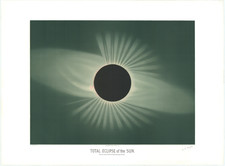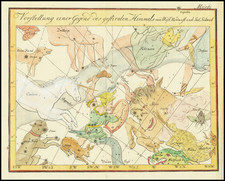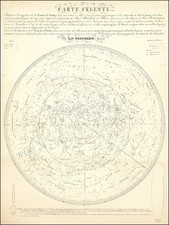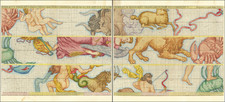Exceptional original hand-coloring and heightening in gold. The best extant example of this pair.
Cellarius's fantastic depiction of the Northern and Southern Hemisphere sky illustrating the pagan constellations as visible from the earth. Here presented in two sheets, one showing the northern ("boreal") sky and one showing the southern ("austral") sky, these were published in the 1661 edition of Cellarius's tremendous Harmonia Macrocosmica. This is a remarkable original-color example that was executed by one of the greatest Dutch colorists of the 17th century.
The celestial maps provide a fantastic image of the stars in a planiform projection. In particular, the chart gives an up-to-date mapping of the constellations of the southern hemisphere, most notable for its inclusion of the most recently observed constellations, i.e., those that could only have been seen on voyages to the deep southern latitudes. It bears noting that many of the Southern Hemisphere constellations had become known to European scholars less than 70 years before this book was published, through the observations of Frederick de Houtman in 1595-97. These were published by the great Dutch astronomer and cartographer Petrus Plancius.
Visible on these two maps are the Southern Cross, Centaur, Hydra, Cancer, Leo, Gemini, Ursa Major, and the line of the zodiac.
A Note on Color and Relative Value
In nice original or later hand-coloring, we have recently asked just shy of $12,000 for this hemispheric pairing; thus, this pair's price of $25,000 might appear aggressive. However, we believe that this pair truly is that much better than any other example out there, and we think you will agree.
This pair's hand-coloring triumphs extend beyond the careful attention to the contrast of the clouds and their subtle yellow background, to the shading of the putti, the extensive highlighting in gold, and most importantly, the additional hand-drawn elaborate zodiac border around the central diagram. The elemental illustrations in this border completely reinvent the image and elevate this beyond any other Cellarius we have seen.
The grisaille painting of the central celestial hemispheres may seem understated at first, but this is actually a wonderfully successful and creative rendering of the night sky in a true-to-life manner; the constellations float out of the formless darkness, punctuated with brilliant flashes of gold, and in stark contrast with the daytime sky surrounding them.
While we have handled many beautiful Cellarius celestial charts in the past, and have seen a few in the trade with exquisite hand-coloring, none has had that key border embellishment, which we take to be indicative of the highest level of late-17th-century Dutch hand-coloring. With its red-and-yellow border, careful gold highlighting, and astoundingly detailed hand-coloring, this may well be the work of Dirk Janszoon Van Santen, the most famous of the Golden Age Dutch colorists.
We bought this map in 2022 along with four other related charts from Cellarius's Harmonia Macrocosmica seu Atlas Universalis et Novus.
Cellarius's Harmonia Macrocosmica
The most sought after of all celestial atlases, this is the only one to be produced during the Dutch cartographic golden age. This work, Cellarius's magnum opus, was produced as a means to illustrate competing theories of celestial mechanics, during an era in which these issues were very much still up for debate. With scholarly precision, but in a manner accessible to the contemporary reader, Cellarius describes, contrasts, and analyzes the hypotheses and observations made by the great thinkers of classical antiquity in addition to those made by his contemporaries.
Of particular interest are the volume's finely engraved images designed to illustrate the concepts introduced. Plates in the work depict the Sun, the Earth, and the stars in a way they had not been seen before. These magnificent depictions take all the strengths of Dutch 17th-century engraving and apply it to the sky: information is simply presented and any critical eye will immediately start to understand the points that Cellarius conveys.
The plates themselves would have been engraved by several Dutch master engravers, but only two have signed their names: Frederik van den Hove, who made the frontispiece, and Johannes van Loon, a noted creator of nautical charts. By 1660, the work was complete.
In the text, Cellarius states his intention to publish a second volume that would adjust for this first volume's overreliance on the Ptolemaic model. This overreliance is present in several ways. In plates that pick a certain model of the Solar System, approximately ten show a pre-Copernican concept of the universe, while only two deal with a Copernican viewpoint and six with a Tychonic system. Further, the plates show little in the way of telescopic discoveries, such as the moons of Saturn. We note but two plates (23 and 28) in which a telescope is in active use among the many representations of astronomical tools in the other plates. It is likely that this intended second volume would have focused more heavily on modern astronomical discoveries.
The plates of the Harmonia can be divided into two sections: the first twenty-one deal with varying hypotheses on how the Solar System functions, citing Claudius Ptolemy, Tycho Brahe, Nicolaus Copernicus, as well as lesser-known figures such as Aratus of Soli and Aristarchus. The plates convey, with two-dimensional in plano and three-dimensional scenographia depictions, how the planetary motions within each model account for contemporary observations. Some plates focus on other themes, these include the influence of the Earth's tilt on climatic effects and how we observe the stars, or the explanation for the phases of the Moon.
The final eight plates look past the Solar System and instead focus on the constellations. While later scientific texts eschew discussions of these human constructions, in Cellarius's time they were still considered of critical scholarly importance. The most important recent innovations, which are displayed in various plates, are the discoveries and naming of Southern Hemisphere stars as well as the attempted renaming of the pagan constellations to fit Christian ideals. Some of these plates show the world as seen from outside the celestial realm, that is, we are looking from beyond the stars into our own existence, and these are truly remarkable in their perspective.
Andreas Cellarius was born in 1596 in Neuhausen and educated in Heidelberg. He emigrated to Holland in the early 17th century, and in 1637 moved to Hoorn, where he became the rector of the Latin School. Cellarius' best-known work is his Harmonia Macrocosmica, first issued in 1660 by Jan Jansson, as a supplement to Jansson's Atlas Novus. The work consists of a series of Celestial Charts begun by Cellarius in 1647 and intended as part of a two-volume treatise on cosmography, which was never issued.











![[ Lyra ] (Stars Heightened in Gold)](https://storage.googleapis.com/raremaps/img/small/83179.jpg)




![[ Twin Hemispheric Maps of the Constellations ] Hemisphere Celeste Septentrional [with] Planisphere Celeste Meridional](https://storage.googleapis.com/raremaps/img/small/103356.jpg)